Shade dwellers
A shady patch of soil - on the cool side of the house, under trees or along a south facing wall - is an opportunity to grow some of our most beautiful plants.
Leaves that evolved to catch the light give us richly contrasting shapes, textures and colours - big and bold, glossy, fine and lacy, or frilled and crinkled. Flowers are more restrained in shady spaces, but they’re by no means absent.
Cold-hardy plants for shady spaces, particularly under trees, include glamorous ‘woodland’ plants such as hostas, ferns and hellebores. Boldly colourful Heuchera and Heucherella also fit this scene. Dicentra (bleeding heart) is one of those treasures that’s much easier to grow in Dunedin than it is in Auckland. But many ‘cool-climate’ plants can be grown in a warm climate when given some shade.
Where there is a warm sheltered spot with no frost, the choice of shade loving plants expands to the subtropical treasures like Vireya rhododendrons and clivias in rich orange or yellow. With thick, strappy leaves, clivias look amazing mass planted under trees, as do NZ native renga renga lilies with their masses of little white lily flowers. Strongly structural bromeliads make excellent container plants for a shady front porch. Or for quick colour in pots, try impatiens or cyclamen.
Not all shade is the same
All plants need light for photosynthesis and no plant will grow in complete darkness, but many are adapted to life with less sun. ‘Full shade’ exists beneath the spreading canopies of mature trees or beside a tall wall or hedge. Deciduous trees cast full shade during summer but let the light through in winter, hence many ’woodland’ natives do their flowering in very early spring. ‘Heavy shade’ beneath evergreen trees or a building that casts its shadow all year-round is the hardest to work with. One solution is to grow plants in containers that can be moved to a brighter location for some time in the light.
It is far easier to find plants for ‘partial shade’, where they get three to six hours of sun each day. Many will grow well in part or full shade, but they’ll reward you with more flowers if you give them more sun. Because to produce the energy it takes to make a flower, a certain amount of sunlight must first be trapped in the leaves.
Shade is not always to blame
When a plant is failing to thrive in a dimly lit part of the garden, it may simply come down to a lack of moisture and nutrients in the soil. Often, shade coincides with poor soil. For example; tree roots may be robbing the soil of moisture and nutrients, or a wall may create a rain shadow. Plants that are not thriving in the shade may simply be screaming out for a drink.
Under large trees where the soil is dry and blocked with roots, the best way to start a garden of shade loving perennials is to create a thick bed of compost a good 30cm deep. Top it off with more organic mulch every year. An irrigation system may also be an option. On the other hand, we’re lucky that many of our best shade plants are also remarkably drought tolerant.
Success in shade
- Bulk-up the soil with compost before planting.
- Mulch regularly to conserve moisture and build up soil structure.
- Apply fertiliser to compensate for the competition from tree roots.
- In very dry areas consider installing an irrigation system.
- Prune trees to let more light and moisture into the soil below.
- Protect young plants and newly emerging spring foliage from slugs and snails.
- Plants grow more slowly in the shade. Start with larger plants for quicker results.
- Plants with white flowers or variegated foliage stand out in the shade.
| Perennials & groundcovers | Common name | Cold hardy | Frost tender | Full shade | Part shade | Dry shade |
| Ajuga reptans | bugle | * | * | * | * | |
| Arthropodium | renga renga | * | * | * | * | |
| Astilbe | false spirea | * | * | |||
| Begonia | begonia | * | * | |||
| Bergenia | elephants ears | * | * | * | * | |
| Brunnera | bugloss | * | * | * | ||
| Caladium | elephant ear | * | * | * | ||
| Convallaria | lily of the valley | * | * | |||
| Dicentra | bleeding heart | * | * | |||
| Elatostema | parataniwha | * | * | * | ||
| Epimedium | barrenwort | * | * | * | * | |
| Farfugium | ligularia | * | * | * | ||
| Helleborus | winter rose | * | * | |||
| Heuchera | coral bells | * | * | * | * | |
| Hosta | plantain lily | * | * | |||
| Liriope | turf lily | * | * | * | * | |
| Ophiopogon | mondo grass | * | * | * | * | |
| Pachysandra | Japanese spurge | * | * | * | * | |
| Polemonium | Jacob's ladder | * | * | * | ||
| Polygonatum | Solomon's seal | * | * | * | ||
| Pulmonaria | lungwort | * | * | * | * |
Easy to grow from seed: Forget-me-not (Myosotis), granny's bonnet (Aquilegia), foxglove (Digitalis), honesty (Lunaria)
| Shrubs | Common name | Cold hardy | Frost tender | Full shade | Part shade | Dry shade |
| Abutilon | Chinese lantern | * | * | |||
| Aucuba | Japanese laurel | * | * | * | * | |
| Buxus | English box | * | * | * | * | |
| Camellia | camellia | * | * | |||
| Daphne | daphne | * | * | |||
| Fuchsia | fuchsia | * | * | |||
| Hydrangea | hydrangea | * | * | |||
| Macropiper | kawakawa | * | * | * | ||
| Rhododendron | azaleas and rhodos | * | * | |||
| Sarcococca | sweet box | * | * | * | * |

1-Oct-2017
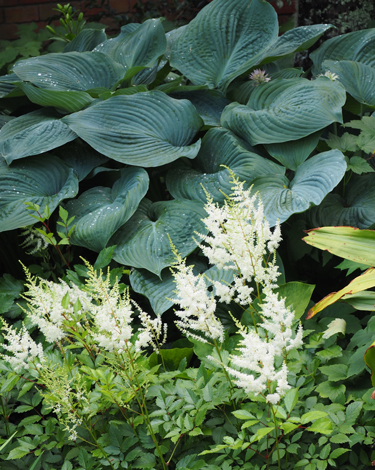
Hosta and Astilbe
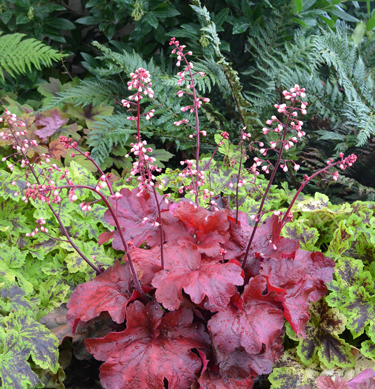
Ferns & Heucheras
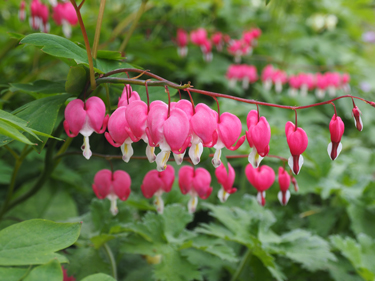
Dicentra spectabilis (bleeding heart)
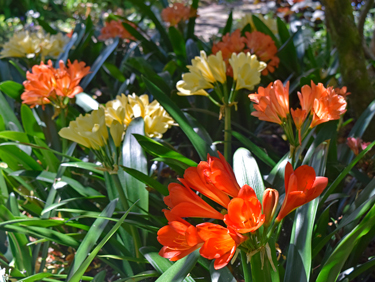
Clivia in orange and yellow
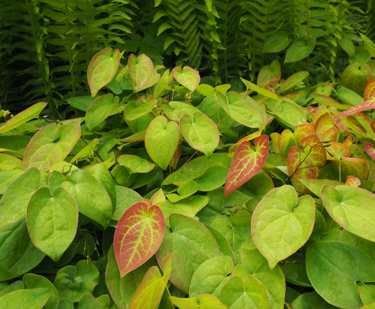
Epimedium sulphureum

